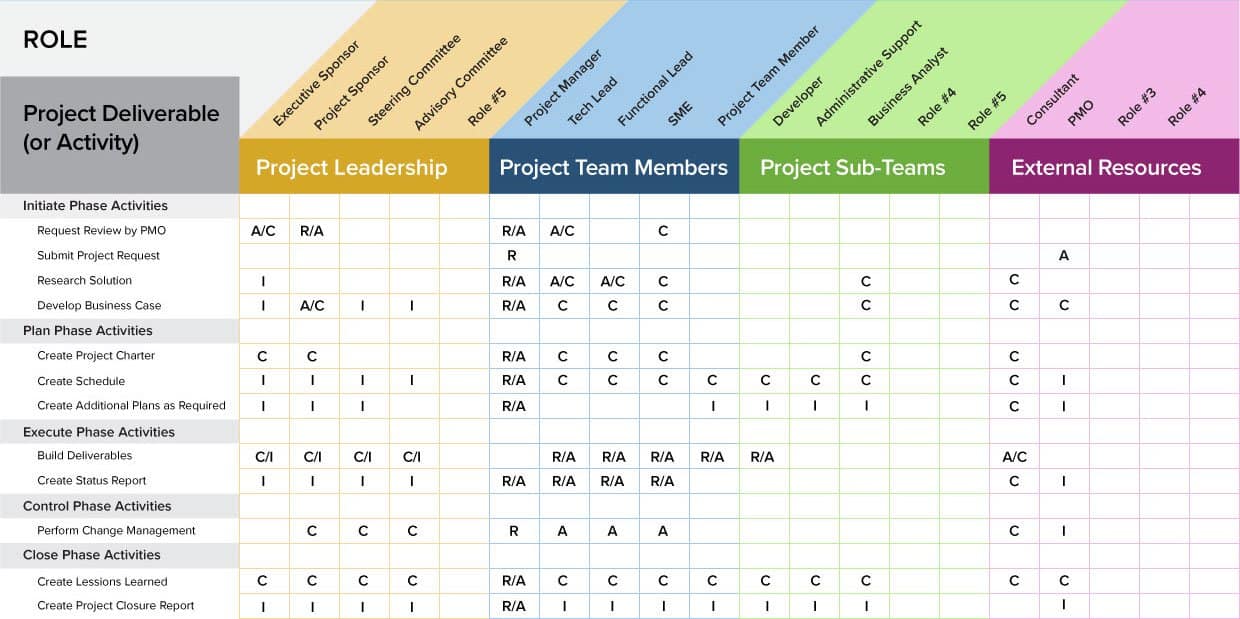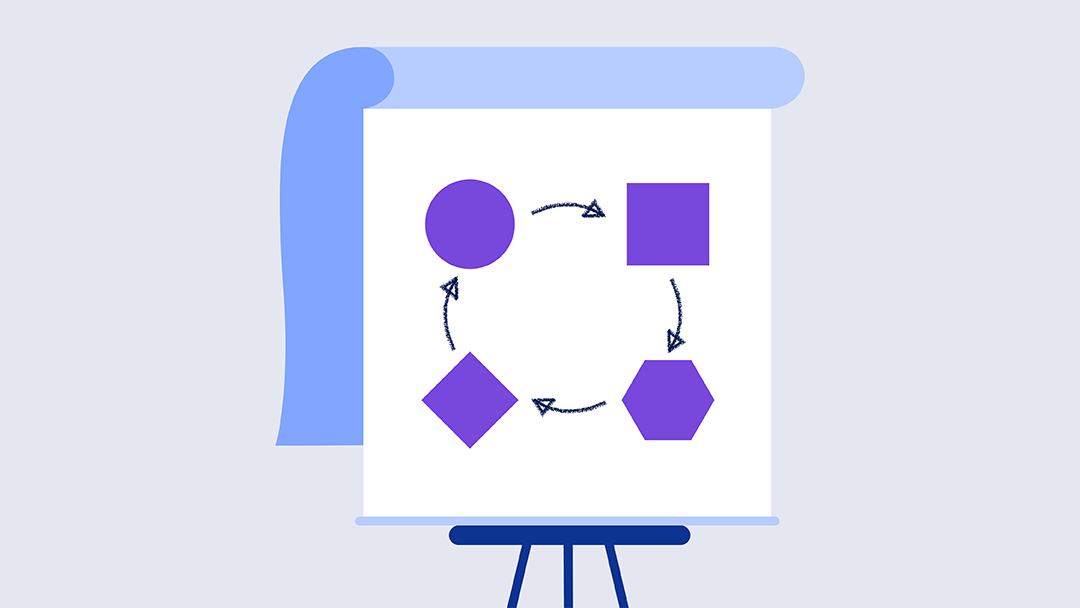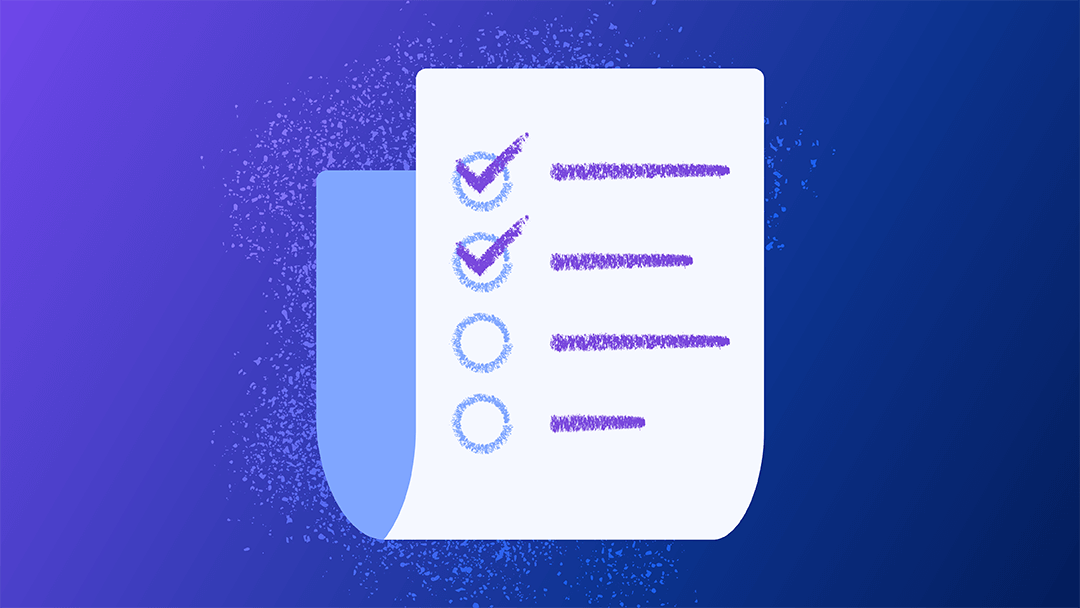The Four Association Types
RACI has four association types: responsible, accountable, consulted, and informed. Responsible roles produce deliverables; accountable roles check the deliverables; consulted roles advise on tasks; and informed roles are kept informed throughout these processes.
- Responsible: These roles are responsible for completing the task or deliverable. For example, if the responsibility role is a technical writer, this person may be responsible for writing online help files. A software developer wouldn’t write the help files, but might incorporate those files into the product, which would be defined as a different task.
- Accountable: This type of role has the final authority on (or is accountable for) the task’s completion. To take the previous example of a technical writer developing online help and a software developer incorporating the help files, a product manager might be responsible for ensuring that the files make it into the product.
- Consulted: This role functions as an adviser to a task. For example, a team may consult with a Scrum Master as a subject matter expert (SME). Consider advisers carefully, as having too many people in this role can stretch the task time and raise the risk of poor performance.
- Informed: Informed team members are kept up to date on task completion. Charting this role helps to illustrate dependencies among tasks and also ensures transparency into task status. It can be difficult to identify those who need to be informed, so consult various roles to determine who needs status updates. For example, the sales manager may require status updates because a customer has a special interest in feature development.
When to Use RACI
A RACI model is a useful tool for general project management. Use a RACI matrix when processes are stalled due to role confusion, or when role authority is not clearly outlined. We’ve outlined some common use cases for RACI below:
- If the approval process is bogged down, it may be due to role confusion.
- If decisions are being overruled often and seemingly arbitrarily, this is also a situation that can benefit from clarifying roles.
- Another situation that frequently occurs is that many people perform the same analysis tasks. When tasks are not getting done, it may be that nobody knows who should be doing them.
- When the authority to perform tasks is not understood, it may be time to define roles and tasks, responsibilities, and authority.
Eliminating this sort of confusion and clarifying roles and tasks is the chief function of a RACI Matrix.
RACI is among the most popular models, but there are several alternatives, including:
- PACSI – Used in situations where multiple stakeholders can review and veto the work of a single accountable person. The roles include Performed, Accountable, Control, Suggested, and Informed.
- RAPID – Created by Bain & Company to clarify decision accountability through clear role and responsibility delineation. The roles include Recommend, Agree, Perform, Input, and Decide.
The Value of RACI
Implementing a RACI model helps you to involve the most qualified people in your projects. Project managers can use RACI to quickly develop charts that provide clarity to the team. Some major benefits of the RACI model are as follows:
- Eliminating role confusion.
- Preventing over-allocation of resources to one project and under-allocation to another.
- Clearly defining roles to all the people who fill them (clear understanding of expectations is key to a smooth project and reduces the need for conflict resolution later).
- Ensuring no task is overlooked when resources are allocated.
- Providing a fast and efficient way to re-allocate resources when there is turnover. New people can quickly identify their roles in a project and the roles of those with whom they must interact.
Finally, because the Informed category is given equal weight, the RACI Matrix encourages communication between roles. Communication is the key to clearly understanding expectations, which results in a smooth project.
RACI Matrices
A RACI matrix is a collection of all project activities associated with the people or roles responsible for each. Your matrix should include all project elements, including planning, testing, design, and support.
To create a RACI matrix, consider the following steps:
- Decide How to Chart the Matrix: You can use any number of tools or templates, including a spreadsheet, whiteboard, or software solution.
- Identify the Project Tasks or Deliverables: Meet with key stakeholders to develop a list of project tasks. For this discussion, tasks include necessary activities, like meetings or events, as well as tangible deliverables, like features or products. Plot tasks across the X or Y axis of the matrix.
For example, if you are charting a software project developed under Agile, the sprint demo meeting may be a required activity and should be included in the matrix as a task. Don’t forget to add maintenance of the RACI Matrix as its own task. The project manager usually maintains the RACI Matrix. - Identify the Project Roles: Project roles are labeled across the other axis of the matrix. The project roles make the matrix more understandable and can be useful for adding any data you may have forgotten. As you identify roles, add any tasks that apply to those roles on the task axis. The task axis is also useful for identifying roles and clarifying resource allocation. This is a good time to assign names to roles as well — one name per role is optimal.
- Label the Intersections of the Axes: Where the X and Y axes intersect, label the intersection with an R, A, C, or I to finalize the matrix with who should be responsible, accountable, consulted, or informed on each task.
RACI Guidelines
While RACI matrices will differ by project, there are some broad guidelines that you should always follow. Above all, your matrix should encourage teamwork and inform all people of their roles and assignments. We’ve laid out additional best practices below:
- Avoid multiple levels of oversight – one level is enough
- Encourage teamwork
- Maintain chart fluidity – make changes as needed and let people know when things change
- Assign only one Accountable per task
- Ensure Accountable assignees have authority to ensure the task is complete
- Avoid too many consultants as they can take up too much time (waiting for answers, gathering input, etc.) while too few can damage performance, so try to find the "sweet spot”
- Inform everyone with a role of their assignment
Finding the Right RACI Template
RACI templates save time and provide a starting point for building your chart. Choose a simple, customizable template to ensure that it is as useful as possible for all team and project types.
Some templates use the X axis for the tasks and Y for roles, and others do the opposite. If tasks exceed roles, as they generally do, it is easier to use the X axis for tasks and the Y for roles as you will be able to see the greatest number of roles per task at a glance on most computer monitors. On the other hand, you may find it easier to filter a chart based on role (for instance, filtering to show only the “I” roles for a given task) with the tasks on the X axis. In addition, most templates use some form of color-coding.
Regardless of which template you select, using one will eliminate a lot of basic work in constructing the chart and will free your time to define roles and tasks.
RACI Project Management
RACI project management focuses on creating and managing a RACI matrix to identify and resolve conflicts in roles and revise role categorization. You should approach analysis as a team and encourage all roles to provide feedback.
A RACI Matrix is analyzed vertically and horizontally. Here are some things to look for when reviewing the role axis (whether this is horizontal or vertical):
- If one role has too many responsibilities, should some responsibilities be reallocated or should more people be assigned to the role?
- If only one person is Accountable, is it reasonable to expect that person to make all decisions and could it threaten the project by creating a bottleneck?
- Here are some things to look for when reviewing the Task axis (whether this is horizontal or vertical):
- If there is a task with no one Responsible, should someone be assigned or should the task be eliminated?
- If there is a task where no one is Accountable, who has decision-making authority?
- If there are multiple people Accountable for a task, avoid conflicts by making a single person accountable.
- If too many people must be consulted, evaluate whether one person can be assigned who talks with others involved.
It is common, during the life of a project, to have team members experience role confusion. A RACI matrix is useful for clearly identifying roles associated with a project and improving productivity, especially when you’re suffering from role confusion. Some signs of role confusion are:
- Concern over who makes decisions—Decision-makers are usually labeled as Accountable, but it may be that decisions are being made by the Responsible party. If that’s the case, the team should know who makes decisions in each situation.
- Finger pointing—If work is not completed on time, finger pointing may result. The key to avoiding this is knowing who is Responsible.
- Poor resource allocation—The RACI Matrix should make resource allocation very clear, but sometimes a single task can be extremely taxing, leading to some issues concerning who should be doing what and when.
- Lack of action because of ineffective communications—If someone is not Informed, they may not know to perform a task.
- Too many consultations because the wrong people are consulted—The Consulted should be clearly labeled to avoid jeopardizing the project schedule.
It is the duty of a project manager to step in if role confusion is suspected and clarify roles to ensure that everyone is aware of expectations.
Smartsheet for Project Management
Smartsheet is a spreadsheet-inspired project management platform with powerful collaboration and communication features. By providing a broad range of views including Gantt, calendar, grid, and dashboards, you can manage projects the way you want. Track project requirements, store documents, create timelines, and organize key details.



